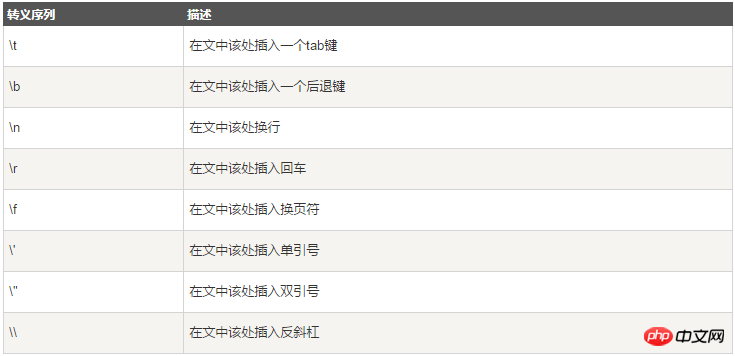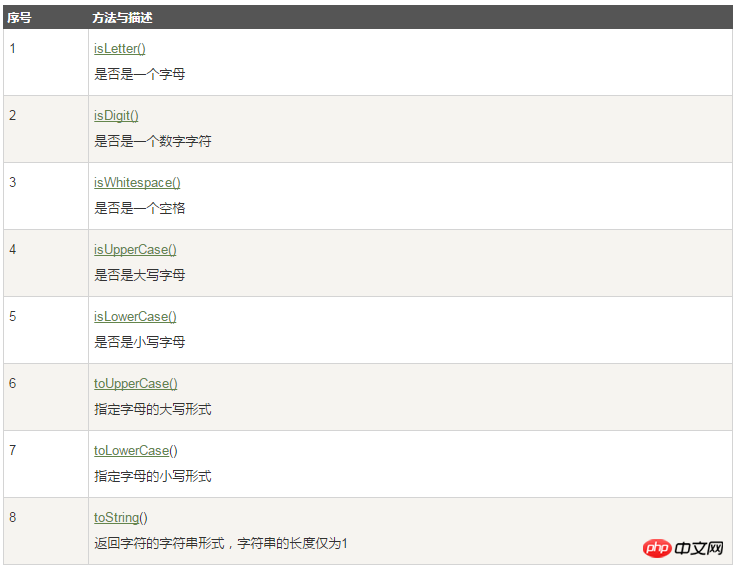Detailed explanation of the Character class in Java
Character class is used to operate on single characters.
The Character class wraps a basic type char value in the object
Instance
char ch = 'a';
// Unicode 字符表示形式
char uniChar = '\u039A';
// 字符数组
char[] charArray ={ 'a', 'b', 'c', 'd', 'e' };However, in the actual development process , we often encounter situations where we need to use objects instead of built-in data types. In order to solve this problem, the Java language provides a wrapper class Character class for the built-in data type char.
The Character class provides a series of methods to manipulate characters. You can use Character's constructor method to create a Character class object, for example:
Character ch = new Character('a');
In some cases, the Java compiler automatically creates a Character object.
For example, when a char type parameter is passed to a method that requires a Character type parameter, the compiler will automatically convert the char type parameter into a Character object. This feature is called boxing, and the converse is called unboxing.
Example
// 原始字符 'a' 装箱到 Character 对象 ch 中 Character ch = 'a'; // 原始字符 'x' 用 test 方法装箱 // 返回拆箱的值到 'c' char c = test('x');
Escape sequence
With a backslash (\) in front character represents an escape character, which has special meaning to the compiler.
The following list shows Java escape sequences:

Example
When a print statement encounters an escape sequence, the compiler can interpret it correctly.
The following example escapes double quotes and outputs:
Test.java file code:
public class Test {
public static void main(String args[]) {
System.out.println("访问\"菜鸟教程!\""); }}The above example compiles and runs the results as follows:
访问"菜鸟教程!"
Character method
The following are the methods of the Character class:

[Related recommendations]
2. About the instance analysis of the packaging class Character
3. About the usage analysis of the Character class
4. Detailed explanation of instances of the Character class
5. Detailed explanation of the differences between Character and char methods
The above is the detailed content of Detailed explanation of the Character class in Java. For more information, please follow other related articles on the PHP Chinese website!

Hot AI Tools

Undress AI Tool
Undress images for free

Undresser.AI Undress
AI-powered app for creating realistic nude photos

AI Clothes Remover
Online AI tool for removing clothes from photos.

Clothoff.io
AI clothes remover

Video Face Swap
Swap faces in any video effortlessly with our completely free AI face swap tool!

Hot Article

Hot Tools

Notepad++7.3.1
Easy-to-use and free code editor

SublimeText3 Chinese version
Chinese version, very easy to use

Zend Studio 13.0.1
Powerful PHP integrated development environment

Dreamweaver CS6
Visual web development tools

SublimeText3 Mac version
God-level code editing software (SublimeText3)

Hot Topics
 Tips for Writing PHP Comments
Jul 18, 2025 am 04:51 AM
Tips for Writing PHP Comments
Jul 18, 2025 am 04:51 AM
The key to writing PHP comments is to clarify the purpose and specifications. Comments should explain "why" rather than "what was done", avoiding redundancy or too simplicity. 1. Use a unified format, such as docblock (/*/) for class and method descriptions to improve readability and tool compatibility; 2. Emphasize the reasons behind the logic, such as why JS jumps need to be output manually; 3. Add an overview description before complex code, describe the process in steps, and help understand the overall idea; 4. Use TODO and FIXME rationally to mark to-do items and problems to facilitate subsequent tracking and collaboration. Good annotations can reduce communication costs and improve code maintenance efficiency.
 Improving Readability with Comments
Jul 18, 2025 am 04:46 AM
Improving Readability with Comments
Jul 18, 2025 am 04:46 AM
The key to writing good comments is to explain "why" rather than just "what was done" to improve the readability of the code. 1. Comments should explain logical reasons, such as considerations behind value selection or processing; 2. Use paragraph annotations for complex logic to summarize the overall idea of functions or algorithms; 3. Regularly maintain comments to ensure consistency with the code, avoid misleading, and delete outdated content if necessary; 4. Synchronously check comments when reviewing the code, and record public logic through documents to reduce the burden of code comments.
 Writing Effective PHP Comments
Jul 18, 2025 am 04:44 AM
Writing Effective PHP Comments
Jul 18, 2025 am 04:44 AM
Comments cannot be careless because they want to explain the reasons for the existence of the code rather than the functions, such as compatibility with old interfaces or third-party restrictions, otherwise people who read the code can only rely on guessing. The areas that must be commented include complex conditional judgments, special error handling logic, and temporary bypass restrictions. A more practical way to write comments is to select single-line comments or block comments based on the scene. Use document block comments to explain parameters and return values at the beginning of functions, classes, and files, and keep comments updated. For complex logic, you can add a line to the previous one to summarize the overall intention. At the same time, do not use comments to seal code, but use version control tools.
 Effective PHP Commenting
Jul 18, 2025 am 04:33 AM
Effective PHP Commenting
Jul 18, 2025 am 04:33 AM
The key to writing PHP comments is clear, useful and concise. 1. Comments should explain the intention behind the code rather than just describing the code itself, such as explaining the logical purpose of complex conditional judgments; 2. Add comments to key scenarios such as magic values, old code compatibility, API interfaces, etc. to improve readability; 3. Avoid duplicate code content, keep it concise and specific, and use standard formats such as PHPDoc; 4. Comments should be updated synchronously with the code to ensure accuracy. Good comments should be thought from the perspective of others, reduce the cost of understanding, and become a code understanding navigation device.
 PHP Commenting Syntax
Jul 18, 2025 am 04:56 AM
PHP Commenting Syntax
Jul 18, 2025 am 04:56 AM
There are three common ways to use PHP comments: single-line comments are suitable for briefly explaining code logic, such as // or # for the explanation of the current line; multi-line comments /*...*/ are suitable for detailed description of the functions or classes; document comments DocBlock start with /** to provide prompt information for the IDE. When using it, you should avoid nonsense, keep updating synchronously, and do not use comments to block codes for a long time.
 PHP Development Environment Setup
Jul 18, 2025 am 04:55 AM
PHP Development Environment Setup
Jul 18, 2025 am 04:55 AM
The first step is to select the integrated environment package XAMPP or MAMP to build a local server; the second step is to select the appropriate PHP version according to the project needs and configure multiple version switching; the third step is to select VSCode or PhpStorm as the editor and debug with Xdebug; in addition, you need to install Composer, PHP_CodeSniffer, PHPUnit and other tools to assist in development.
 PHP Comparison Operators
Jul 18, 2025 am 04:57 AM
PHP Comparison Operators
Jul 18, 2025 am 04:57 AM
PHP comparison operators need to pay attention to type conversion issues. 1. Use == to compare values only, and type conversion will be performed, such as 1=="1" is true; 2. Use === to require the same value as the type, such as 1==="1" is false; 3. Size comparison can be used on values and strings, such as "apple"
 PHP Comments for Teams
Jul 18, 2025 am 04:28 AM
PHP Comments for Teams
Jul 18, 2025 am 04:28 AM
The key to writing PHP comments is to explain "why" rather than "what to do", unify the team's annotation style, avoid duplicate code comments, and use TODO and FIXME tags reasonably. 1. Comments should focus on explaining the logical reasons behind the code, such as performance optimization, algorithm selection, etc.; 2. The team needs to unify the annotation specifications, such as //, single-line comments, function classes use docblock format, and include @author, @since and other tags; 3. Avoid meaningless annotations that only retell the content of the code, and should supplement the business meaning; 4. Use TODO and FIXME to mark to do things, and can cooperate with tool tracking to ensure that the annotations and code are updated synchronously and improve project maintenance.







